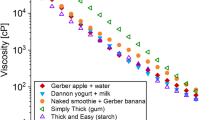Abstract
Infants experiencing dysphagia may undergo a videofluoroscopic swallow study (VFSS) to assess radiologically their coordination for sucking, swallowing, and breathing. No studies known to these authors have investigated whether the liquids used during infant radiological procedures are representative of liquids routinely fed to infants (e.g., formula). This study used an Advanced Rheometric Expansion System (ARES) strain-controlled rheometer to compare prethickened antiregurgitation formula, regular (thin) infant formula, and two types of regular infant formula, hand-thickened with a thickening agent and with liquid Polibar™ (barium-impregnated liquid). The viscosity, density, and yield stress of all samples were determined. Heated versus cooled liquids were compared. Results showed a significant difference in all rheological and material property parameters among the barium-impregnated liquids and the thickened and unthickened infant formula. This finding has important implications for the interpretation of the radiological results and subsequent clinical recommendations.
Similar content being viewed by others
Abbreviations
- Reg-CowIF (37°C):
-
Regular (thin) cow’s milk powdered infant formula at body temperature (37°C)
- Reg-SoyIF (37°C):
-
Regular (thin) soy milk powdered infant formula at body temperature (37°C)
- PreThick-CowIF (37°C):
-
Prethickened cow’s milk powdered infant formula at body temperature (37°C)
- HndThick-CowIF (37°C):
-
Hand-thickened cow’s milk infant formula at body temperature (37°C)
- HndThick-SoyIF (37°C):
-
Hand-thickened soy milk infant formula at body temperature (37°C)
- Polibar™ BaLiqu (34.5°C):
-
Polibar™ liquid barium sulphate, heated (34.5°C)
- Polibar™ BaLiqu (25°C):
-
Polibar™ liquid barium sulphate, at room temperature (25°C)
References
Lefton-Greif M, Carroll JL, Loughlin GM. Long-term follow-up of oropharyngeal dysphagia in children without apparent risk factors. Pediatr Pulmonol. 2006;41(11):1040–8.
Cichero JAY, Hay G, Murdoch BE, Halley PJ. Videofluoroscopic fluids versus mealtime fluids: differences in viscosity and density made clear. J Med Speech Lang Pathol. 1997;5(3):203–15.
Cichero JAY, Jackson O, Halley PJ, Murdoch BE. How thick is thick? A multi-centre study of the rheological and material property characteristics of meal-time fluids and videofluoroscopy fluids. Dysphagia. 2000;15(4):188–200.
Stuart S, Motz JM. Viscosity in infant dysphagia management: comparison of viscosity of thickened liquids used in assessment and thickened liquids used in treatment. Dysphagia. 2009;24(4):412–22.
Garcia JM, Chambers E, Matta Z, Clark M. Serving temperature viscosity measurements of nectar- and honey-thick liquids. Dysphagia. 2008;23:65–75.
Sopade PA, Halley PJ, Cichero JAY, Ward LC, Liu J, Varliveli S. Rheological characterization of food thickeners marketed in Australia in various media for the management of dysphagia. III. Fruit juice as a dispersing medium. J Food Eng. 2008;86(4):604–15.
Cook DJ, Hollowood TJ, Linforth RST, Taylor AJ. Oral shear stress predicts flavour perception in viscous solutions. Chem Senses. 2003;28:11–23.
Bird RB, Dai GC, Yarusso BJ. The rheology and flow of viscoplastic materials. Rev Chem Eng. 1983;1:1–70.
Nguyen QD, Boger DV. Measuring the flow properties of yield stress fluids. Annu Rev Fluid Mech. 1992;24:47–88.
Strowd L, Kyzima J, Pillsbury D, Valley T, Rubin B. Dysphagia dietary guidelines and the rheology of nutritional feeds and barium test feeds. Chest. 2008;133(6):1397–401.
Rommel N, Dejaeger E, Bellon E, Smet M, Veereman-Wauters G. Videomanometry reveals clinically relevant parameters of swallowing in children. Int J Pediatr Otorhinolaryngol. 2006;70:1397–405.
McDaniel MR, Barker E, Lederer CL. Sensory characterization of human milk. J Dairy Sci. 1989;72:1149–58.
Fink TA, Ross JB. Are we testing a true thin fluid? Dysphagia. 2009;24:285–98.
Arvedson J, Rogers B, Buck G, Smart P, Msall M. Silent aspiration prominent in children with dysphagia. Int J Pediatr Otorhinolaryngol. 1994;28:173–81.
Mirrett PL, Riski JE, Glascott J, Johnson V. Videofluoroscopic assessment of dysphagia in children with severe spastic cerebral palsy. Dysphagia. 1994;9:174–9.
Geddes DT, Kent JC, Mitoulas LR, Hartmann PE. Tongue movement and intra-oral vacuum in breastfeeding infants. Early Hum Dev. 2008;84:471–7.
Waterland RA, Berkowitz RI, Stunkard AJ, Stallings VA. Calibrated-orifice nipples for measurement of infant nutritive sucking. J Pediatr. 1998;132:523–6.
Author information
Authors and Affiliations
Corresponding author
Rights and permissions
About this article
Cite this article
Cichero, J., Nicholson, T. & Dodrill, P. Liquid Barium is not Representative of Infant Formula: Characterisation of Rheological and Material Properties. Dysphagia 26, 264–271 (2011). https://doi.org/10.1007/s00455-010-9303-3
Received:
Accepted:
Published:
Issue Date:
DOI: https://doi.org/10.1007/s00455-010-9303-3




